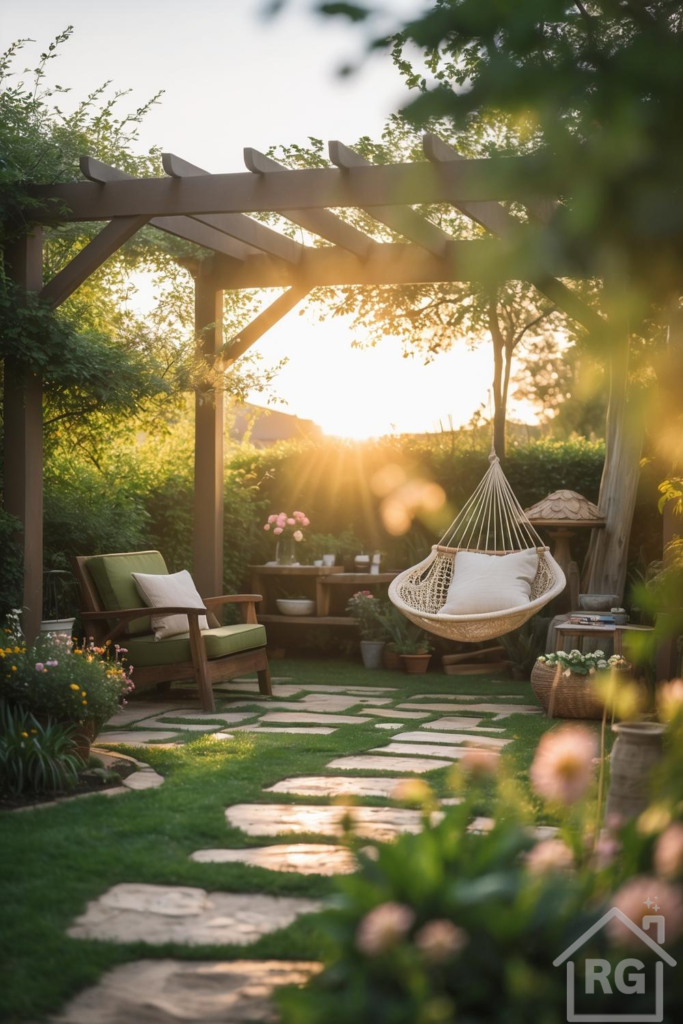
Imagine stepping into your backyard and being greeted by the warm glow of the setting sun filtering through a charming wooden pergola. A gentle breeze rustles the leaves of lush plants, and a comfortable chair invites you to unwind. This idyllic scene, reminiscent of a perfect golden hour, isn’t just a dream—it’s a tangible oasis you can create.
This guide will walk you through the key elements to design and build your own enchanting pergola garden. From the foundational structure of the pergola itself to the inviting pathways, cozy seating, and vibrant plant life, we’ll cover everything you need to transform your outdoor space into a serene retreat filled with natural charm.
The Pergola: Your Garden’s Architectural Heart
A pergola does more than just provide shade; it defines an outdoor room, adds architectural interest, and offers a framework for climbing plants, transforming a simple patio or garden spot into a captivating retreat.
Material Matters for Durability and Style
- Wood: The classic choice, offering natural beauty.
- Cedar and Redwood: Naturally resistant to rot and insects, they weather beautifully to a silvery gray or can be stained to maintain their rich color. They are premium choices.
- Pressure-Treated Pine: A more budget-friendly option, it’s chemically treated for longevity but requires regular sealing and staining for best appearance and protection.
- Metal: Aluminum is lightweight, rust-proof, and low-maintenance, often powder-coated in various colors. Steel is stronger but heavier and must be properly treated to prevent rust. Metal pergolas can offer a more modern or industrial aesthetic.
- Vinyl: The ultimate low-maintenance option. Vinyl pergolas won’t rot, warp, or need painting, and come in various colors and styles, though they may lack the natural charm of wood.
Design and Installation Considerations
Consider the size of your space and the pergola’s purpose. Will it cover a dining area or a cozy seating nook? The style can range from traditional with ornate details to sleek and modern. For the roof, you can leave it open, add more slats for increased shade, or even incorporate a retractable canopy for versatility. While DIY pergola kits are available, larger or more complex designs might benefit from professional installation to ensure structural integrity and safety.
Paving the Way: Natural Stone Pathways
The flagstone path, as seen in many inspiring garden images, meanders organically, inviting exploration and connecting different garden zones. Such pathways add immense character and a sense of permanence to your outdoor space.
Choosing and Laying Your Flagstones
- Flagstone Varieties: Options like slate (varied colors, can split into thin layers), sandstone (warm, earthy tones), and limestone (creamy whites to grays) offer different aesthetics. Choose stones that are at least 1.5-2 inches thick for durability.
- Installation Tips:
- Plan the Path: Lay out the desired shape with a hose or rope.
- Excavate: Dig out 4-6 inches of soil.
- Base Layer: Add a 2-4 inch layer of compacted gravel for drainage, followed by a 1-2 inch layer of sand for leveling.
- Lay Stones: Arrange the flagstones, aiming for consistent spacing (1-3 inches). Use a rubber mallet to set them into the sand.
- Fill Gaps: The image shows grass growing between stones, which creates a soft, natural look. Other options include creeping thyme, moss (for shady areas), decorative gravel, or polymeric sand for a more solid finish.
For a simpler approach, consider individual stepping stones set directly into a lawn or gravel bed.
Creating Cozy Corners: Outdoor Furniture Selection
Comfortable and stylish seating transforms a pretty garden into a usable outdoor living space. The pictured scene often features a classic wooden armchair and an inviting macrame hanging chair, perfect for relaxation.
Key Furniture Pieces for Comfort and Style
- Armchairs & Sofas: Look for deep seating and weather-resistant materials. Teak is a top choice for outdoor wood furniture due to its natural oils that resist water and pests. Acacia and eucalyptus are also durable hardwoods. Ensure cushions are made with outdoor-specific fabrics like Sunbrella or Olefin, which resist fading, mildew, and water. The olive green cushions often seen in such settings blend beautifully with surrounding foliage.
- Hanging Chairs: A macrame or wicker hanging chair adds a touch of bohemian charm and a unique relaxation spot. Ensure it’s securely anchored to a strong pergola beam or a dedicated stand. Cream or off-white provides a lovely contrast to the greenery.
- Arrangement: Position furniture to encourage conversation, take advantage of views, or create a secluded nook. Ensure easy traffic flow around the pieces.
The Living Tapestry: Planting for Beauty and Ambiance
Lush greenery and pops of floral color are essential to the garden’s serene atmosphere. Layering plants of different heights, textures, and colors creates depth and interest, truly bringing your pergola garden to life.
Plant Suggestions (Temperate Climate, Sun to Part-Shade)
Choosing the right plants will depend on your local climate, but here are some popular choices that thrive in temperate conditions with varying sun exposure:
- For the Pergola (Climbers):
- Climbing Roses: Varieties like ‘New Dawn’ (pale pink) or ‘Zephirine Drouhin’ (thornless, cerise pink) add romance.
- Clematis: Offers a wide range of flower colors and shapes.
- Wisteria: Stunning fragrant blooms, but requires a very sturdy structure and regular pruning.
- Honeysuckle: Fragrant and attracts pollinators.
- Border and Bedding Plants:
- Hostas and Ferns: Ideal for shadier spots beneath the pergola or larger shrubs, offering varied foliage.
- Ornamental Grasses: (e.g., Feather Reed Grass, Fountain Grass) add movement and texture, thriving in sun.
- Perennials: Daylilies, Echinacea (Coneflower), Salvia, Lavender, and Coreopsis provide recurring color. The pink flowers often seen in garden images could be Phlox, Dianthus, or compact Dahlias.
- Potted Plants:
- Annuals: Geraniums, Petunias, Impatiens (for shade) offer vibrant seasonal color.
- Herbs: Rosemary, thyme, and mint can be both beautiful and useful.
- Small Shrubs/Evergreens: Dwarf conifers or boxwoods provide year-round structure in pots.
Container Choices & Plant Care
Terracotta pots, often featured in rustic garden designs, offer a classic look and good aeration for roots. Glazed ceramic pots add color, while wooden or woven basket planters (ensure they have liners) enhance the natural aesthetic. Good drainage is crucial for all container plants. Use quality potting mix and water according to each plant’s needs, especially during dry periods.
Setting the Mood: Ambiance, Lighting, and Decor
The golden hour light creates a magical atmosphere in photos, but you can extend this enchantment into the evening and enhance the overall feel of your garden with thoughtful additions.
Magical Lighting Solutions
- String Lights: Draped across the pergola, they create a festive and warm glow.
- Path Lights: Solar-powered or low-voltage lights can illuminate walkways for safety and beauty.
- Lanterns: Placed on tables or along steps, lanterns with LED candles add a cozy touch.
- Uplighting: Strategically placed spotlights can highlight trees or architectural features of the pergola.
Thoughtful Decor Touches
Simple elements can make a big impact. A vase of fresh-cut flowers from the garden, like soft pink blooms on a table, adds elegance. Woven baskets for planters or storage contribute texture. Consider wind chimes for gentle sound or a small, discreet water feature for tranquil bubbling.
Harmonizing Colors and Textures
The ideal color palette for a serene garden is harmonious: earthy browns of the wood, deep greens of foliage, creamy whites and beiges in textiles and stones, accented by soft pinks from flowers and the warm gold of sunset light. These natural, warm colors promote relaxation. Textures from the rough stone, smooth wood, woven macrame, and soft cushions add tactile interest and depth.
DIY Ideas for a Personal Touch
Add your unique flair to the garden with these simple DIY projects:
- Build Simple Planter Boxes: Use reclaimed wood for a rustic look.
- Create Stepping Stones: Decorate concrete pavers with mosaics or leaf imprints.
- Paint Terracotta Pots: Add patterns or solid colors to match your decor.
- Sew Outdoor Cushion Covers: Customize your seating with unique fabrics.
Your Dream Pergola Garden Awaits
Creating a serene outdoor space like the one you’ve imagined is a journey of combining structural elements, comfortable furnishings, and the living beauty of plants. By focusing on durable materials, thoughtful plant choices, and personal touches, you can transform your yard into a cherished retreat.
Start by sketching your ideas, considering your climate and space, and gradually bring your vision to life. Your own golden hour garden paradise is within reach!
